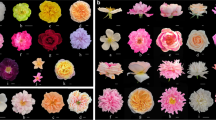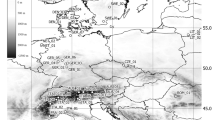Abstract
As the second species used for commercial coffee, evaluation of Coffea canephora Pierre ex Froehner population genetics is a challenging task for coffee breeding. This study examined the pattern of genetic variability and genetic relationships of cultivated and wild populations of C. canephora sampled across the Guineo-Congolese region of Africa and some improved populations maintained in field genebanks. A total of 293 individuals, sampled from 17 populations, were genotyped with 39 nuclear microsatellite markers. Genetic diversity and structure were investigated with both a model-based and a graphical approach; isolation by distance was also tested. Relationships between the diversity clusters are discussed with regard to differentiation due to several glacial refuges during the Last Glacial Maximum (LGM). High genetic diversity within C. canephora is confirmed with a mean number of alleles of 11.85 per marker, a mean gene diversity of 0.72 and a mean observed heterozygosity of 0.36. An overall structure of two main groups (Guinean and Congolese) subdivided in six subgroups (2 for the Guinean and 4 for the Congolese) was found, including one described for the first time in the Guinean group. A fine structure within the Guinean group was also newly detected. Genetic structure of C. canephora appears to be consistent with its geographic repartition at the continent scale. Structure of diversity was found in accordance with localizations of refuge zones during LGM and migration from this period. Results from this genetic structure study raise our capabilities to better manage and use the collections of genetics resources for breeding purposes. Those results will be used in future association studies to optimize the number of genotypes to be phenotyped.




Similar content being viewed by others
References
Adams JM, Faure H (1997) Preliminary vegetation maps of the world since the last glacial maximum: an aid to archaeological understanding. J Archaeol Sci 24:623–647
Adibolo Y, Bertrand B (1988) Etude de l’origine de la variété Niaouli au Togo et au Bénin. Café Cacao Thé 32:293–297
Anthony F, Diniz LEC, Combes M-C, Lashermes P (2010) Adaptive radiation in Coffea subgenus Coffea L. (Rubiaceae) in Africa and Madagascar. Plant Syst Evol 285:14. doi:10.1007/s00606-009-0255-8
Berthaud J (1986) Les ressources génétiques pour l’amélioration des caféiers africains diploïdes ORSTOM, Paris
Berthaud J, Guillaumet JL (1978) Les caféiers sauvages en Centrafrique. Résultats d’une mission de prospection (janvier-février 1975). Café Cacao Thé 22:171–187
Berthaud J, Anthony F, Le Pierrès D (1984) Les caféiers de la Nana. Résultats des observations faites en collection en Côte d’Ivoire. Café Cacao Thé 28:3–13
Bioportal (2010) A high-performance computing server. Available at http://www.bioportal.uio.no/. University of Oslo
Bodard L (1965) Historique des caféiers de RCI 1:1–131
Charrier A (1971) Study of pollination in cultivated coffee by labelling pollen with radioactive phosphorus and sulphur. Café Cacao Thé 15:181–190
Cochard B, Adon B, Rekima S, Billotte N, Desmier de Chenon R, Koutou A, Nouy B, Omoré A, Razak Purba A, Glazzmann JC, Noyer JL (2009) Geographic and genetic structure of African oil palm diversity suggests new approaches to breeding. Tree Genet Genomes 5:493–504
Combes MC, Andrzejewski S, Anthony F, Bertrand B, Rovelli P, Graziosi G, Lashermes P (2000) Characterization of microsatellite loci in Coffea arabica and related coffee species. Mol Ecol 9:1178–1180
Coombs JA, Letcher BH, Nislow KH (2007) CREATE 1.0 a software to create and convert codominant molecular data. Available online at http://www.lsc.usgs.gov/CAFL/Ecology/Software.html
Cubry P (2008) Structuration de la diversité génétique et analyse des patrons de déséquilibre de liaison de l’espèce Coffea canephora Pierre ex Froehner. Thèse de doctorat de l’Université Montpellier II, Montpellier. http://tel.archives-ouvertes.fr/tel-00365078/fr/
Cubry P, Musoli P, Legnathé H, Pot D, de Bellis F, Poncet V, Anthony F, Dufour M, Leroy T (2008) Diversity in coffee assessed with SSR markers: structure of the genus Coffea and perspectives for breeding. Genome 51:50–63
Davis A, Stoffelen P (2006) An annotated taxonomic conspectus of the genus Coffea (Rubiaceae). Bot J Linn Soc 152:465–512
Davis A, Tosh J, Ruch N, Fay Fls M (2011) Growing coffee: Psilanthus (Rubiaceae) subsumed on the basis of molecular and morphological data; implications for the size, morphology, distribution and evolutionary history of Coffea. Bot J Linn Soc 167:357–377. doi:10.1111/j.1095-8339.2011.01177.x
Dufour M, Hamon P, Noirot M, Risterucci AM, Leroy T (2001) Potential use of SSR markers for Coffea spp. Genetic mapping [CD-ROM]. In: ASIC (ed) 19th international scientific colloquium on coffee, Trieste, 2011. Paris, France
Dussert S, Lashermes P, Anthony F, Montagnon C, Trouslot P, Combes MC, Berthaud J, Noirot M, Hamon S (1999) Le caféier, Coffea canephora. In: Hamon P, Seguin M, Perrier X, Glaszmann JC (eds) Diversité génétique des plantes tropicales cultivées. CIRAD, Montpellier, pp 175–194
Evanno G, Regnaut S, Goudet J (2005) Detecting the number of clusters of individuals using the software STRUCTURE: a simulation study. Mol Ecol 14:2611–2620
Excoffier L, Laval G, Schneider S (2005) Arlequin ver. 3.0: An integrated software package for population genetics data analysis. Evol Bioinform Online 1:47–50
Falush D, Stephens M, Pritchard JK (2003) Inference of population structure using multilocus genotype data: linked loci and correlated allele frequencies. Genetics 164:1567–1587
Geromel C, Ferreira LP, Guerreiro SM, Cavalari AA, Pot D, Pereira LF, Leroy T, Vieira LG, Mazzafera P, Marraccini P (2006) Biochemical and genomic analysis of sucrose metabolism during coffee (Coffea arabica) fruit development. J Exp Bot 57:3243–3258
Glaubitz J (2004) CONVERT: a user friendly program to reformat diploid genotypic data for commonly used population genetic software packages. Mol Ecol Notes 4:309–310
Gomez C, Dussert S, Hamon P, Hamon S, Kochko A, Poncet V (2009) Current genetic differentiation of Coffea canephora Pierre ex A. Froehn in the Guineo-Congolian African zone: cumulative impact of ancient climatic changes and recent human activities. BMC Evol Biol 9:167
ICO (2011) International Coffee Organization. Exports by exporting countries to all destinations, March 2011. http://www.ico.org/prices/m1.htm
Jakobsson M, Rosenberg NA (2006) CLUMPP: CLUster Matching and Permutation Program. http://rosenberglab.bioinformatics.med.umich.edu/software.html
Leroy T, Montagnon C, Cilas C, Charrier A (1994) Reciprocal recurrent selection applied to Coffea canephora Pierre. II. Estimation of genetic parameters. Euphytica 74:121–128
Leroy T, Marraccini P, Dufour M, Montagnon C, Lashermes P, Sabau X, Ferreira LP, Jourdan I, Pot D, Andrade AC, Glaszmann JC, Vieira LG, Piffanelli P (2005) Construction and characterization of a Coffea canephora BAC library to study the organization of sucrose biosynthesis genes. Theor Appl Genet 111:1032–1041
Leroy T, De Bellis F, Legnate H, Kanamura E, Gonzales G, Pereira LF, Andrade AC, Charmetant P, Montagnon C, Cubry P, Marraccini P, Pot D, de Kochko A (2011) Improving quality of African Robustas: QTL for agronomic and quality related traits in Coffea canephora. Tree Genet Genomes. doi:10.1007/s11295-011-0374-6
Lin C, Mueller LA, Mc Carthy J, Crouzillat D, Pétiard V, Tanksley SD (2005) Coffee and tomato share common gene repertoires as revealed by deep sequencing of seed and cherry transcripts. Theor Appl Genet 112:114–130
Liu K, Muse SV (2005) PowerMarker: an integrated analysis environment for genetic marker analysis. Bioinformatics 21:2128–2129
Maley J (1996) The African rain forest - main characteristics of changes in vegetation and climate from the Upper Cretaceous to the Quaternary. In: Alexander IJ, Swaine MD, Watling R (eds) Proceedings of the royal society of Edinburgh. The Royal Society of Edinburgh, Edinburgh, pp 31–73
Michalakis Y, Excoffier L (1996) A generic estimation of population subdivision using distances between alleles with special reference for microsatellite loci. Genetics 142:1061–1064
Montagnon C (2000) Optimisation des gains génétiques dans le schéma de sélection récurrente réciproque de Coffea canephora Pierre. Ecole Nationale Supérieure Agronomique de Montpellier, Montpellier
Montagnon C, Leroy T, Yapo A (1992) Diversité génotypique et phénotypique de quelques groupes de caféiers (Coffea canephora Pierre) en collection. Café Cacao Thé 36:187–198
Montagnon C, Leroy T, Yapo A (1993) Caractérisation et évaluation de caféiers Coffea canephora prospectés dans des plantations de Côte d’Ivoire. Café Cacao Thé 37:115–119
Musoli P, Cubry P, Aluka P, Billot C, Dufour M, De Bellis F, Pot D, Bieysse D, Charrier A, Leroy T (2009) Genetic differentiation of wild and cultivated populations: diversity of Coffea canephora Pierre in Uganda. Genome 52:634–646. doi:10.1139/G09-037
Peakall R, Smouse PE (2006) Genalex 6: genetic analysis in Excel. Population genetic software for teaching and research. Mole Ecol Notes 6:288–295
Perrier X, Jacquemoud-Collet JP (2006) DARwin software. http://darwin.cirad.fr/darwin
Perrier X, Flori A, Bonnot F (2003) Data analysis methods. In: Hamon P, Seguin M, Perrier X, Glaszmann JC (eds) Genetic diversity of cultivated tropical plants. Enfield Science Publishers, Montpellier, pp 43–76
Poncet V, Hamon P, Minier J, Carasco C, Hamon S, Noirot M (2004) SSR cross-amplification and variation within coffee trees (Coffea spp.). Genome 47:1071–1081
Poncet V, Dufour M, Hamon P, Hamon S, de Kochko A, Leroy T (2007) Development of genomic microsatellite markers in Coffea canephora and their transferability to other coffee species. Genome 50:1156–1161
Portères R (1937) Etude sur les caféiers spontanés de la section Eucoffea. Leur répartition, leur habitat, leur mise en culture et leur sélection en Côte d’Ivoire. I Répartition et habitat. Annales de l’Afrique Occidental Française et Etrangère 1:68–91
Portères R (1959) Valeur agronomique des caféiers de types Kouilou et Robusta cultivés en Côte d’Ivoire. Café Cacao Thé 3:3–14
Pritchard JK, Stephens M, Donnelly P (2000) Inference of population structure using multilocus genotype data. Genetics 155:945–959
Rosenberg NA (2004) DISTRUCT: a program for the graphical display of population structure. Mol Ecol Notes 4:137–138. Available at http://rosenberglab.bioinformatics.med.umich.edu/software.html
Rovelli P, Mettulio R, Anthony F, Anzueto F, Lashermes P (2000) Microsatellites in Coffea arabica L. In: Sera T, Soccol CR, Pandey A, Roussos S (eds) Coffee biotechnology and quality. Kluwer Academic Publishers, the Netherlands, pp 123–133
Sie RS, N Goran JAK, Montagnon C, Akaffou DS, Cilas C (2005) Assessing genetic diversity in a germplasm collection of kola trees (Cola nitida (Vent.) Schott et Endl.) using enzymatic markers. Plant Genet Resour Newsl: 59–64
Slatkin M (1995) A measure of population subdivision based on microsatellite allele frequencies. Genetics 139:457–462
Thomas AS (1935) Types of Robusta coffee and their selection in Uganda. East Afr J Rural Dev 1:193–198
Tuberosa R, Salvi S (2006) Genomics-based approaches to improve drought tolerance of crops. Trends Plant Sci 11:405–412
Weir BS 1996 Genetic Data Analysis II: Methods for discrete population genetic data Sinauer Associates
White F (1979) The Guineo-Congolian region and its relationships to other phytochoria. Bulletin du Jardin Botanique National de la Belgique 49:11–55
Acknowledgments
We thank Nestlé Centre R&D in Tours (France) and Dr Crouzillat for providing us with some genomic and EST-derived microsatellite markers. We also thank Dr Christophe Montagnon and Jean-Pierre Labouisse for helpful comments and discussions on the manuscript. The main plant material came from the Divo Research 235 Centre, CNRA, Ivory Coast, and from the NARO-COREC collection in Uganda. Other materials were kindly provided by IAPAR, Paranà state, Brazil.
Author information
Authors and Affiliations
Corresponding author
Rights and permissions
About this article
Cite this article
Cubry, P., De Bellis, F., Pot, D. et al. Global analysis of Coffea canephora Pierre ex Froehner (Rubiaceae) from the Guineo-Congolese region reveals impacts from climatic refuges and migration effects. Genet Resour Crop Evol 60, 483–501 (2013). https://doi.org/10.1007/s10722-012-9851-5
Received:
Accepted:
Published:
Issue Date:
DOI: https://doi.org/10.1007/s10722-012-9851-5




